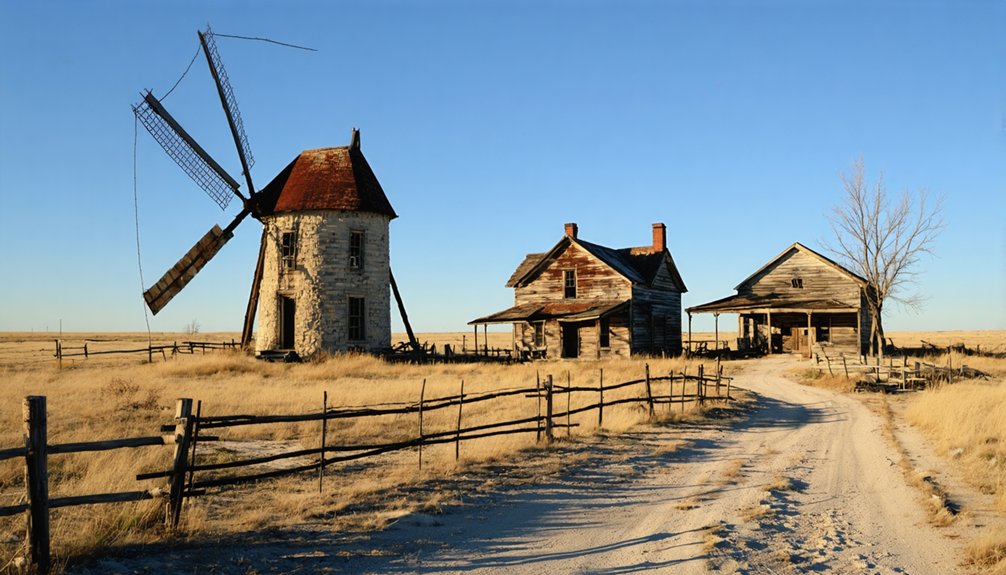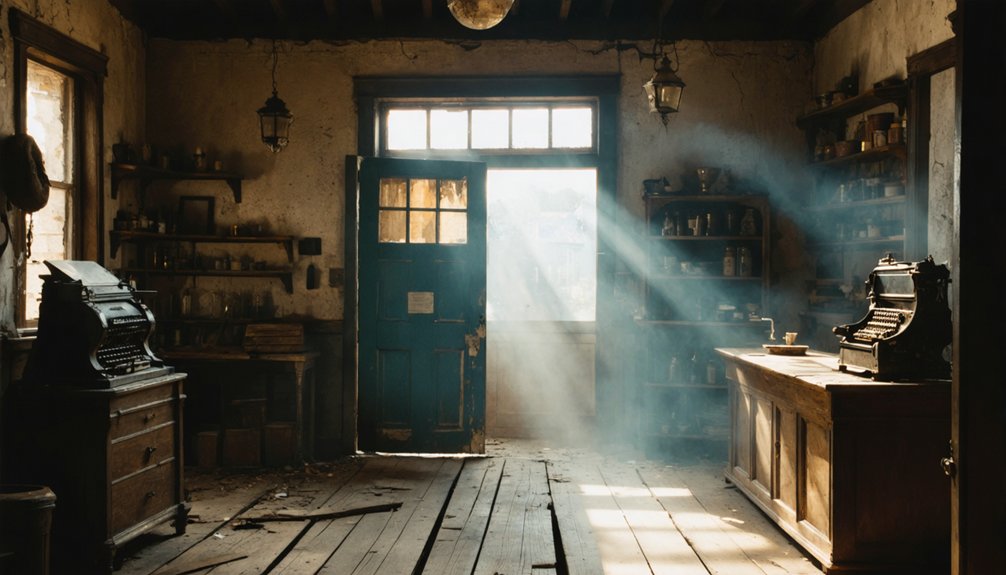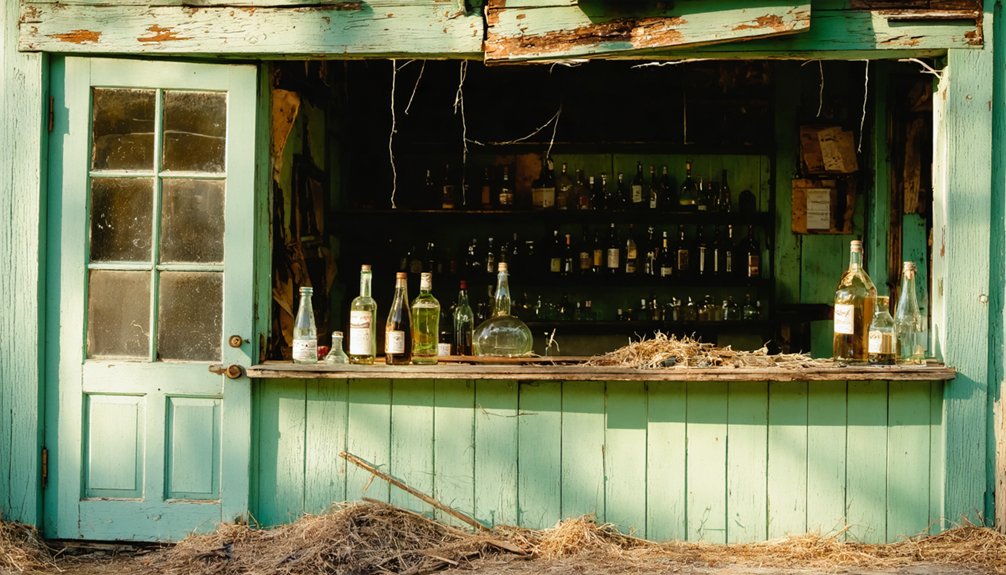You’ll find Callahan City‘s remains in Callahan County, Texas, where it briefly served as the county seat in 1877 with over 150 residents. The settlement emerged as an essential trading post along the Western Trail, facing early challenges from Comanche raids and supply chain difficulties. When the Texas and Pacific Railway bypassed the town in 1880-81, settlers relocated to rail-connected communities like Baird. Today, only the historic cemetery marks this once-promising frontier outpost’s story.
Key Takeaways
- Established in 1877, Callahan City served as the first county seat of Callahan County and thrived as a Western Trail trading post.
- The town lost its county seat status twice, first to Belle Plain in 1877 and finally to Baird in 1883.
- When the Texas and Pacific Railway bypassed Callahan City in 1880, the town experienced rapid economic decline and population loss.
- The settlement faced significant challenges from Native American raids and supply chain difficulties due to its remote frontier location.
- Today, only the historic cemetery remains as evidence of Callahan City’s existence as an early Texas frontier settlement.
The Birth of a Frontier Settlement
While the Texas Legislature established Callahan County in 1858 from parts of Bexar, Bosque, and Travis counties, permanent settlement didn’t begin until James Dulan built the area’s first shelter along Hubbard Creek in 1859.
Early settlers faced significant frontier challenges, with Comanche Indians dominating the region until the 1870s. The Whitten family braved these dangers, establishing a camp on Deep Creek before 1863. The region’s Rolling Plains terrain shaped the early settlement patterns.
You’ll find that the first true permanent residence emerged in 1868 when A.A. and Caroline Hart built their home on South Prong of Pecan Bayou. As more pioneers arrived, including the Hittsons, Eubankses, and Merchant brothers, ranching operations expanded across the untamed landscape. The area soon became a bustling hub as over 100,000 cattle moved through on the Western Trail to Dodge City.
The establishment of John Hittson’s Three Circle Ranch in 1873 marked a turning point in the area’s development.
Native American Relations and Early Conflicts
During Callahan City’s early development, you’d find settlers organizing into local Minute Men defense corps under Captain M.W. Hall in 1873 to counter the persistent Native American raids on ranches and homesteads. Southern Plains Indians had established dominance in the region through superior horsemanship and military prowess.
These raids, primarily conducted by Comanche and Lipan Apache groups, disrupted settlement patterns and resulted in significant livestock losses, including a notable 1873 incident where horses were driven off from ranches along the Sabano. The ongoing conflicts with Native Americans mirrored earlier tensions faced by Texas Ranger captain Callahan during his twenty years of service.
Minute Men Defense Corps
In the early 2000s, the Minutemen Civil Defense Corps emerged as a controversial civilian border patrol organization, positioning itself as a response to perceived government failures in border security.
Under Chris Simcox’s leadership, militia motivations centered on preventing illegal border crossings, primarily in Arizona, Texas, and California. While their standard operating procedures prohibited direct confrontations, the group’s armed volunteers conducted military-style patrols that heightened border tensions. The organization claimed to have captured over 5,000 immigrants during their border operations.
You’ll find their presence was particularly notable near places like Miracle Valley Bible College in Arizona, where they established surveillance camps. The area had historically been home to Comanche raiders who controlled vast territories through horseback mobility and hunting.
Their activities, often framed around protecting “white” identity, drew criticism for promoting nationalist ideologies in regions historically shaped by Native American and Hispanic populations.
This vigilante approach echoed earlier patterns of settler-militia conflicts that had impacted indigenous communities throughout Texas’s history.
Raids and Settlement Impact
Throughout the mid-1800s, Lipan Apache warriors posed a significant threat to central Texas settlements, fielding up to 500 fighters for raids that targeted Euro-American homesteads.
By 1855, the situation had grown so severe that Governor Pease authorized Texas Rangers under James Callahan to launch counter-raids. When Callahan pursued raiders into Mexico, the conflict escalated after his controversial burning of Piedras Negras, intensifying cross-border tensions. Local settler Woodson Blasingame openly criticized Callahan’s aggressive tactics after the raid. In April 1856, this bitter disagreement culminated in Blasingame’s fatal confrontation with Callahan.
You’ll find that these raids and reprisals shaped the region’s development until the 1870s, when the last major Indian threats were finally suppressed. The defeat of the Comanches at Palo Duro Canyon in 1874 and continued Texas Ranger patrols eventually secured the area, allowing settlers to establish permanent ranches and homesteads without fear of raids.
Life in the Wild West Trading Post
You’d find Callahan City’s daily frontier commerce centered around its two general stores and post office, where cowboys and settlers bartered goods, shared news, and conducted vital trading for their survival on the Western Trail.
While corrals and branding pens supported the bustling cattle trade, the town’s strategic position made it a significant resupply point for ranchers moving herds northward to Kansas markets in the late 1870s.
Security remained a constant concern for merchants and travelers alike, with the community staying vigilant even after U.S. troops and Texas Rangers helped reduce Comanche threats in the region after 1874.
The early settlers faced harsh conditions while establishing their homes, with the first permanent residence built by A. A. and Caroline Hart in 1868.
The community served as the temporary county seat in 1877 before being overshadowed by the growing settlement of Belle Plaine.
Frontier Commerce Daily Operations
Life at the frontier trading post hummed with daily activities that kept commerce flowing through Callahan City. You’d find the general store bustling with settlers purchasing essential supplies, from tools to foodstuffs, while ranchers bartered their livestock and agricultural goods.
The post office served as your crucial link to the outside world, while local newspapers kept you informed of regional developments and market prices.
Daily trade centered around the strategic location near water sources and cattle trails, where you’d witness wagon trains stopping to resupply and cattlemen driving their herds northward.
Community interaction flourished as the trading post became your social hub, where you’d exchange news with fellow settlers, conduct business with traveling merchants, and rely on basic law enforcement to maintain order in this frontier ecosystem.
Saloons and Trading Culture
While cattle drives and dusty trails defined the exterior of Callahan City, its saloons pulsed at the heart of local commerce and society.
You’d find these wooden-framed establishments serving multiple roles – part trading post, part community center, and part frontier entertainment venue. Local entrepreneurs operated these crucial hubs where you could barter for essential supplies, hear the latest news, or join a game of poker.
The saloon architecture reflected its diverse functions, with space for storing goods like tobacco and coffee alongside areas for socializing.
You’d witness cowboys fresh off the Western Trail trading stories over whiskey while merchants negotiated deals nearby.
Through seasonal cattle drives, these establishments thrived as unofficial lodging spots and trading centers, where everything from horse tack to handcrafted leather goods changed hands.
Supply Routes and Security
Despite its strategic location near Deep Hole on Deep Creek, Callahan City faced persistent supply chain challenges that tested the resilience of its merchants and settlers.
You’d have waited months for essential goods from Fort Worth, with freight wagons battling difficult terrain and constant security threats. The town’s supply challenges intensified as Indian raids plagued the region throughout the 1870s, claiming lives like Bob Leslie’s in 1874.
Local security strategies evolved through militia groups such as Captain M.W. Hall’s Minute Men, who protected supply trains and cattle drives.
When the railroad bypassed Callahan City in 1880, you’d have witnessed the town’s decline as merchants struggled with increasingly unreliable overland supply chains.
Water access remained essential, but without rail connection, the town couldn’t sustain its position as a critical trading post.
The Battle for County Dominance

After its formation in 1858, Callahan County remained sparsely settled until after the Civil War due to Comanche threats in the region.
By 1877, you’d have witnessed intense county seat rivalry as settlers established control over the area’s administration. Callahan City first claimed the county seat on July 3, 1877, with over 150 residents, but Belle Plain won it through election just months later on October 13.
The true game-changer came with the Texas and Pacific Railway in 1880-81. The railroad’s decision to bypass Belle Plain and establish stations in Baird shifted economic influence dramatically.
Baird, named after railroad director Matthew Baird, secured the county seat by January 16, 1883, thanks to its strategic rail access, repair shops, and growing population, leaving Callahan City to fade into ghost town status.
Railroad Dreams and Broken Promises
Before the Texas and Pacific Railway‘s arrival in 1880, Callahan City stood as a promising commercial hub along the Western Trail, where merchants served over 100,000 head of cattle annually during the 1870s.
The town’s railroad expectations were shattered when the T&P chose to bypass it, leading to devastating economic repercussions.
The impact of this decision manifested in four critical ways:
- Merchants struggled with lengthy freight delays from Fort Worth
- Population dispersed as settlers moved to rail-connected towns
- Commercial activity shifted to Baird, the new railroad division point
- The town’s eventual abandonment left only its cemetery
You’ll find it ironic that the very railroad meant to bring prosperity to the region ultimately sealed Callahan City’s fate, redirecting growth to towns like Baird while leaving broken promises in its wake.
The Path to Abandonment

The convergence of economic, political, and environmental forces steadily dismantled Callahan City’s future from 1877 to 1905.
You’ll find the town’s decline began when Belle Plain secured the county seat in 1877, exposing Callahan City’s economic vulnerabilities. Without railroad connections, the settlement couldn’t compete with better-connected neighbors.
The devastating drought of 1886-1887 delivered another blow, drying up the crucial Deep Creek water hole and driving ranchers away.
As the Western Cattle Trail‘s importance faded, population shifts toward railroad towns like Baird sealed Callahan City’s fate.
You can trace the final chapter through the systematic closure of businesses, schools, and finally the post office in 1905.
What began as a promising settlement along a cattle trail ended as another West Texas ghost town.
What Remains Today: A Historical Legacy
Modern visitors to Callahan City‘s former location will find little evidence of the once-thriving frontier settlement, save for its historic cemetery which stands as the primary physical remnant.
While historical documentation preserves the town’s legacy in county archives and regional memory, physical traces have largely vanished beneath rural farmland and natural vegetation.
The cemetery preservation efforts highlight four enduring aspects of Callahan City’s heritage:
- Tangible connections to pioneer families through marked gravesites
- Historical reference point for genealogical researchers and descendants
- Living proof of the town’s role as an early county seat
- Symbol of Texas frontier settlement patterns and westward expansion
You’ll find the site accessible via rural roads, though it lacks formal facilities.
The town’s story lives on primarily through written records and oral histories, serving as a powerful reminder of frontier town impermanence.
Frequently Asked Questions
What Was the Population of Callahan City at Its Peak?
You’ll find historical records don’t provide exact population figures, but based on population trends and historical significance, experts estimate Callahan City likely peaked at no more than a few hundred residents.
Were There Any Famous Outlaws or Gunfights in Callahan City?
Truth is stranger than fiction, but you won’t find any outlaw legends or gunfight history here. Historical records don’t show any famous outlaws or documented shootouts in this particular Texas settlement.
What Businesses and Services Existed in Callahan City Besides Basic Amenities?
You’d find mercantile shops, saloons, a newspaper office, a hotel, a drugstore, blacksmith services, a jail, and a post office. Local merchants catered specifically to cattle drivers along the Western Trail.
How Many Original Buildings From Callahan City Still Stood in 1900?
You won’t find evidence of any original buildings standing by 1900, as poor historic preservation and shifting administrative priorities led to the dismantling or decay of structures with architectural significance.
Did Any Descendants of Original Callahan City Settlers Remain in the Area?
Like scattered seeds in the wind, you won’t find clear evidence of descendant stories remaining in the ghost town itself, though some family legacies likely continued elsewhere in Callahan County after 1880.
References
- https://texashighways.com/travel-news/four-texas-ghost-towns/
- https://www.texasescapes.com/TexasGhostTowns/Callahan-City-Texas.htm
- http://onanunderwood5.blogspot.com/2015/08/reh-and-callahan-county-by-damon-c.html
- https://www.ghosttowns.com/states/tx/callahancity.html
- https://atlas.thc.texas.gov/Details/5059004737
- https://www.texasescapes.com/TexasTowns/BellePlainTexas/BellePlainTexas.htm
- https://www.tshaonline.org/handbook/entries/callahan-city-tx
- https://en.wikipedia.org/wiki/Belle_Plain
- https://www.texasalmanac.com/places/callahan-county
- https://en.wikipedia.org/wiki/Callahan_City



